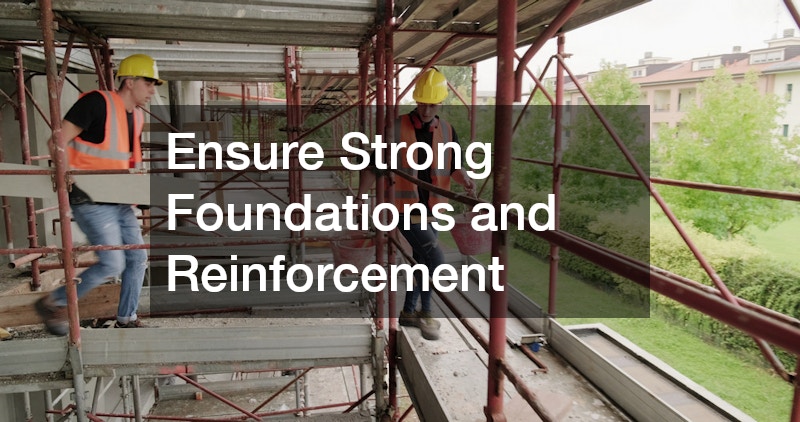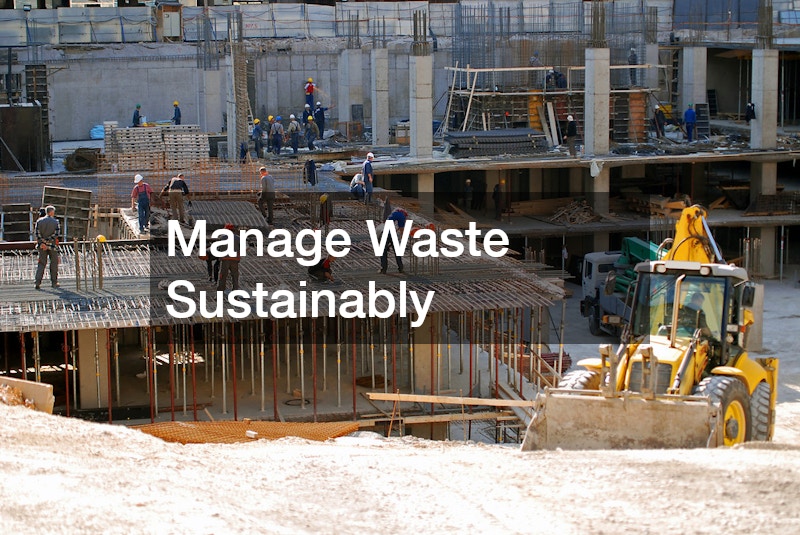Commercial construction projects are among the most complex undertakings in the building industry. They require meticulous planning, coordination, and attention to detail to ensure that every aspect, from the foundation to the finishing touches, is executed flawlessly. Whether you’re constructing a new office complex, a retail space, or an industrial facility, understanding the critical elements of a successful commercial construction initiative is essential.
Effective commercial projects involve more than just assembling materials and following blueprints. They require strategic planning, proper resource allocation, and a clear understanding of the construction process from start to finish. Decisions made early in the project, such as choosing durable materials or selecting experienced contractors, can have a profound impact on the quality, safety, and longevity of the final structure.
From sourcing high-quality materials to managing on-site logistics and sustainability practices, every phase of a commercial construction project demands careful attention. By implementing strategic planning and relying on expert guidance, project leaders can streamline operations, reduce delays, and ultimately deliver a structure that is both functional and durable. In this guide, we will explore top tips for planning and executing commercial builds, covering everything from material selection and foundation reinforcement to worker facilities and waste management.
Choose Durable Materials for Long-Lasting Structures
Selecting the right materials is one of the most critical steps in any construction project. Durable materials not only enhance the longevity of a building but also reduce maintenance costs over time. When planning commercial builds, it’s essential to prioritize materials that can withstand environmental stress, heavy usage, and natural wear and tear.
Steel, concrete, and high-quality masonry are among the top choices for long-lasting structures. Using materials sourced from reputable suppliers ensures that your construction builds meet the highest standards of durability and safety. For instance, partnering with a local steel fabrication provider can guarantee precise, custom-made components that align perfectly with your project specifications. Local steel fabrication services often have in-depth knowledge of regional building codes and can provide guidance on the best types of steel for specific structural needs.
Additionally, choosing durable materials contributes to the overall structural integrity of the building. For example, high-grade steel beams can support heavier loads, while reinforced concrete can resist cracking and other structural issues. Incorporating quality materials into your construction builds also reflects a commitment to sustainability, as long-lasting structures reduce the need for frequent replacements and repairs.
By carefully considering the materials used in your build and working with skilled local steel fabrication teams, you set a solid foundation for a safe, efficient, and enduring project. This approach not only protects your investment but also ensures that the final structure will stand the test of time.

Ensure Strong Foundations and Reinforcement
A strong foundation is the backbone of any successful commercial construction project. Foundations bear the weight of the entire structure, and insufficient reinforcement can lead to costly structural failures. Proper planning and execution during this phase are non-negotiable for achieving long-lasting results.
Rebar fabrication plays a crucial role in foundation reinforcement. Rebar, or reinforcing steel, strengthens concrete and helps it resist tension forces, ensuring that your construction remains stable under heavy loads. Collaborating with reputable rebar fabrication specialists ensures that each piece is manufactured to precise specifications and delivered on time for smooth integration into the foundation.
Attention to soil conditions, drainage, and load distribution is vital for a stable foundation. Soil testing and geotechnical analysis can help identify potential issues that might compromise the structure over time. Incorporating reinforced concrete and other modern construction techniques allows your build to withstand natural settling, shifting, or extreme weather conditions.
Ensuring strong foundations and reinforcement is not just about structural integrity; it’s about safety and long-term project sustainability. Investing in high-quality rebar fabrication and adhering to best practices in foundation design lays the groundwork for successful, resilient commercial builds that can endure decades of use.
Stock the Right Essentials for Smooth Operations
A well-stocked construction site is essential for maintaining efficiency and minimizing delays. Having all the necessary tools, equipment, and materials on hand allows your team to focus on productive work rather than hunting for supplies.
Visiting a reliable builders supply store ensures access to essential items, from nails and screws to heavy-duty machinery and protective gear. Stocking up on quality materials contributes to smoother construction builds, as workers can proceed without unnecessary interruptions. Keeping a clear inventory system also reduces the risk of over-ordering or running out of critical items mid-project.
In addition to materials, ensuring that specialized equipment is available can streamline your workflow. For instance, having access to scaffolding, power tools, and safety equipment in advance allows teams to work efficiently while minimizing downtime. Partnering with reputable suppliers and regularly assessing inventory levels ensures that your commercial build progresses on schedule.
By focusing on stocking the right essentials, construction managers can prevent operational bottlenecks, maintain productivity, and create an environment where commercial builds can proceed smoothly from one phase to the next.

Streamline Your Project From Start to Finish
Project management is a cornerstone of successful commercial builds. Streamlining processes, tracking progress, and coordinating resources are all crucial to keeping the project on schedule and within budget.
Construction management involves overseeing every aspect of the build, from initial design to final inspection. Effective management practices include setting clear timelines, defining roles and responsibilities, and establishing communication protocols among team members. Utilizing project management software can further enhance coordination, providing real-time updates and reducing the risk of miscommunication.
Additionally, efficient construction management helps in mitigating risks and addressing challenges proactively. From unexpected weather delays to supply chain disruptions, a well-managed project can adapt without compromising quality. By integrating robust construction management techniques into your construction, you create a seamless workflow that maximizes efficiency while maintaining high standards.
Streamlining your project from start to finish not only ensures timely completion but also contributes to better budget control, improved safety, and overall satisfaction among stakeholders. It’s a critical step toward delivering a successful and professional commercial build.
Partner With Experts for Reliable Construction
Working with experienced professionals is vital for achieving reliable results in commercial construction. Collaborating with experts ensures that each aspect of the project is executed with precision, safety, and compliance in mind.
Metal building contractors, for instance, bring specialized knowledge in fabricating and assembling steel structures. Their expertise ensures that new builds meet structural requirements while adhering to industry best practices. Choosing the right contractors reduces the risk of errors and delays, enhancing the overall quality of the project.
Additionally, experts can provide valuable insights into cost-effective solutions, innovative construction methods, and compliance with local building codes. By leveraging their experience, project leaders can make informed decisions that benefit both the short-term progress and long-term durability of the structure.
Partnering with skilled professionals in your commercial builds not only increases efficiency but also instills confidence that the project will be completed to the highest standards. Expert collaboration is a key factor in delivering safe, reliable, and high-quality structures that serve their intended purpose for years to come.

Design Safe and Efficient Frameworks
A well-designed framework ensures that a new building is both safe and functional. Structural design requires careful planning, precise calculations, and the integration of multiple engineering disciplines.
Engaging a structural engineering consultant is crucial for optimizing the framework of your construction builds. These specialists evaluate load-bearing requirements, material strengths, and environmental considerations to create designs that maximize safety and efficiency. A consultant’s expertise helps prevent structural weaknesses and ensures compliance with building codes.
Effective framework design also considers long-term maintenance and adaptability. By planning for future expansions, upgrades, or modifications, project managers can create flexible structures that meet evolving business needs. Integrating safety features, such as fire-resistant materials and emergency exits, further enhances the protection of occupants and assets.
Designing safe and efficient frameworks is an investment in the overall success of your commercial builds. With guidance from a structural engineering consultant, you can achieve a balance between functionality, safety, and durability that stands the test of time.
Plan for Heavy Lifting and On-Site Logistics
Heavy lifting and logistics management are essential components of commercial construction. Proper planning ensures that large materials and equipment are moved safely and efficiently, minimizing the risk of accidents or delays.
A crane rental is a practical solution for handling oversized materials, such as steel beams or prefabricated components. By coordinating with reputable crane rental providers, construction teams can execute heavy lifts with precision and safety. Planning the timing and placement of cranes on-site is crucial for maintaining workflow and avoiding bottlenecks during construction builds.
In addition to equipment, logistics planning includes organizing storage areas, scheduling deliveries, and coordinating personnel. Efficient on-site logistics reduce downtime, prevent material damage, and create a smoother workflow. By integrating these practices into your commercial builds, project managers can maintain momentum while ensuring safety and operational efficiency.
Proper planning for heavy lifting and logistics ultimately contributes to timely project completion, cost savings, and a safer work environment. It is an essential strategy for managing the complex demands of modern commercial construction.
Secure Your Worksite Effectively
Construction sites are vulnerable to theft, vandalism, and unauthorized access. Implementing effective security measures is critical for protecting materials, equipment, and personnel throughout the duration of the project.
Temporary fencing is a common and practical solution for securing commercial builds. It creates a clear boundary, deters unauthorized entry, and allows project managers to control access points. In addition, fencing can help protect workers and visitors from potential hazards on the site.
Security measures should also include monitoring systems, lighting, and protocols for handling deliveries and personnel access. By combining physical barriers with strategic planning, construction managers can maintain a secure environment, reducing the risk of loss or accidents. Effective site security contributes to the overall success and safety of your construction builds, providing peace of mind for both workers and stakeholders.

Manage Waste Sustainably
Sustainable construction practices are increasingly important in modern commercial builds. Proper waste management not only reduces environmental impact but also improves efficiency and compliance with regulations.
Construction recycling services can help divert materials such as concrete, metal, and wood from landfills. By implementing a waste management plan, project managers can reduce disposal costs and promote environmentally responsible practices. Integrating recycling into your construction builds demonstrates a commitment to sustainability and aligns with industry best practices.
Additionally, careful planning of material usage, efficient ordering, and on-site sorting of waste contribute to cleaner, safer work environments. Reducing waste also minimizes delays caused by cluttered or obstructed work areas, allowing projects to progress more smoothly. By prioritizing sustainability and effective waste management, new builds can achieve both environmental responsibility and operational efficiency.
Provide Comfortable On-Site Facilities for Workers
Worker comfort and well-being are essential for maintaining productivity and morale on construction sites. Proper facilities ensure that employees have access to rest areas, sanitation, and hydration throughout the workday.
Porta potty rentals are a practical solution for providing convenient sanitation facilities on-site. Well-maintained units improve hygiene, reduce health risks, and create a more comfortable environment for workers. In addition, portable facilities save time by minimizing the need for workers to leave the site for basic needs.
Other considerations include shaded break areas, water stations, and first aid facilities. Investing in worker comfort reflects a commitment to safety and efficiency, encouraging employees to perform at their best. By prioritizing on-site facilities, construction managers create a positive work environment that supports productivity and reduces potential downtime during commercial builds.
Commercial construction projects require careful planning, quality materials, and expert construction practices to ensure durability and longevity. From steel fabrication to construction management, every aspect of the construction process plays a crucial role in creating long-lasting structures. By prioritizing durability, safety, and sustainability, you can create commercial builds that stand the test of time and meet the needs of businesses and communities.
By choosing durable materials, reinforcing foundations, partnering with experts, and managing logistics effectively, builders can streamline their projects and achieve successful outcomes. With a focus on quality craftsmanship, advanced technology, and sustainable practices, builders can create structures that not only meet current needs but also support future generations. Construction projects that prioritize durability and sustainability are not only a sound investment but also contribute to the overall well-being of communities and the environment.



